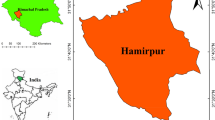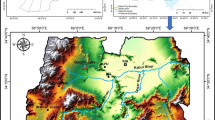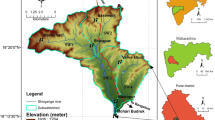Abstract
Jaspura watershed a part of Yamuna basin is situated in drought prone area lying in the Banda district of Bundelkhand region, Uttar Pradesh, India. The drastic decline of groundwater level and consistently drying up of the phreatic aquifer has led to the acute shortage of groundwater in the study area. The situation is further aggravated due to base flow in the areas adjoining the major order streams. To mitigate such problem in study area, MIF technique, combined with RS and GIS, has been effectively used to delineate the potential recharge zone using seven thematic layers, viz., LULC, soil, slope, drainage density (Dd), geomorphology, depth to water level map of post-monsoon, and groundwater fluctuation map. Relative rates and weight of each influencing factor have been calculated on the basis of major and minor effect of these thematic layers. Based on their influence on groundwater recharge capacity using seven thematic layers under potential zone, five classes under artificial recharge have been identified, viz., very high (96.4 km2), high (157.4 km2), moderate (146.1 km2), low (72.9 km2), and very low (34.2km2). The runoff in 15 micro-watersheds has been estimated using SCS-CN approach. Integration of runoff and potential recharge zone has yielded the suitable sites and type of groundwater recharge structure. On the basis of its percolation tank (PT), check dam (CD) and sub-surface dam (SD) have been identified as feasible and suitable groundwater recharge structure.













Similar content being viewed by others
Data Availability
All the data have been generated by the author and are original in nature.
Code availability
Not applicable.
References
Sharma SK, Vairavamoorthy K (2009) Urban water demand management: prospects and challenges for the developing countries. Water Environ J 23:210–218. https://doi.org/10.1111/j.1747-6593.2008.00134.x
Thakur JK, Thakur RK, Ramanathan AL et al (2011) Arsenic contamination of groundwater in Nepal-an overview. Water (Switzerland) 3:1–20. https://doi.org/10.3390/w3010001
Taylor RG, Taylor RG (2013). Ground water and climate change. https://doi.org/10.1038/nclimate1744
Agarwal R, Garg PK (2016) Remote sensing and GIS based groundwater potential & recharge zones mapping using multi-criteria decision making technique. Water Resour Manag 30:243–260. https://doi.org/10.1007/s11269-015-1159-8
CGWB (2014) annual report. Govt. of India, Central ground water board Ministry of Water Resources, River Development and Ganga Rejuvenation
Jha, Madan Kumar and SP (2006) Applications of remote sensing and GIS technologies in groundwater hydrology: past, present and future. Bayreuth: BayCEER
Chowdary VM, Ramakrishnan D, Srivastava YK et al (2009) Integrated water resource development plan for sustainable management of mayurakshi watershed, India using remote sensing and GIS. Water Resour Manag 23:1581–1602. https://doi.org/10.1007/s11269-008-9342-9
Singh JP, Singh D, Litoria PK (2009) Selection of suitable sites for water harvesting structures in Soankhad watershed, Punjab using remote sensing and geographical information system (RS&GIS) approach- a case study. J Indian Soc Remote Sens 37:21–35. https://doi.org/10.1007/s12524-009-0009-7
Ibrahim MB (2009) Rainwater harvesting for urban areas: a success story from Gadarif City in Central Sudan. Water Resour Manag 23:2727–2736. https://doi.org/10.1007/s11269-009-9405-6
Kadam AK, Kale SS, Pande NN et al (2012) Identifying potential rainwater harvesting sites of a semi-arid, basaltic region of Western India, using SCS-CN method. Water Resour Manag 26:2537–2554. https://doi.org/10.1007/s11269-012-0031-3
Agarwal R, Garg PK, Garg RD (2013) Remote sensing and GIS based approach for identification of artificial recharge sites. Water Resour Manag 27:2671–2689. https://doi.org/10.1007/s11269-013-0310-7
Wada Y, Van Beek LPH, Van Kempen CM et al (2010) Global depletion of groundwater resources. Geophys Res Lett 37:1–5. https://doi.org/10.1029/2010GL044571
Eyquem J (2007) Using fluvial geomorphology to inform integrated river basin management. Water Environ J 21:54–60. https://doi.org/10.1111/j.1747-6593.2006.00046.x
Fuentes I, Vervoort RW (2020) Site suitability and water availability for a managed aquifer recharge project in the Namoi basin. Australia J Hydrol Reg Stud 27:100657. https://doi.org/10.1016/j.ejrh.2019.100657
Bouwer H (2002) Artificial recharge of groundwater: hydrogeology and engineering. Hydrogeol J 10:121–142. https://doi.org/10.1007/s10040-001-0182-4
Ibrahim-Bathis K, Ahmed SA (2016) Geospatial technology for delineating groundwater potential zones in Doddahalla watershed of Chitradurga district, India. Egypt J Remote Sens Sp Sci 19:223–234. https://doi.org/10.1016/j.ejrs.2016.06.002
Bhattacharya AK (2010) Artificial ground water recharge with a special reference to India. Int J Res Rev Appl Sci - IJRRAS 4:214–221
Shaban A, Khawlie M, Abdallah C (2006) Use of remote sensing and GIS to determine recharge potential zones: The case of Occidental Lebanon. Hydrogeol J 14:433–443. https://doi.org/10.1007/s10040-005-0437-6
Yeh HF, Lee CH, Hsu KC, Chang PH (2009) GIS for the assessment of the groundwater recharge potential zone. Environ Geol 58:185–195. https://doi.org/10.1007/s00254-008-1504-9
Singh LK, Jha MK, Chowdary VM (2017) Multi-criteria analysis and GIS modeling for identifying prospective water harvesting and artificial recharge sites for sustainable water supply. J Clean Prod 142:1436–1456. https://doi.org/10.1016/j.jclepro.2016.11.163
Science C, Ahmed A (2020) Artificial recharge structures for groundwater augmentation in Mysuru Taluk of Karnataka State, India using geospatial technology. J Environ Sci Comput Sci Eng Technol. https://doi.org/10.24214/jecet.a.9.4.65274
Kim B, Anderson K, Lee SH, Kim H (2014) A real option perspective to value the multi-stage construction of rainwater harvesting systems reusing septic tank. Water Resour Manag 28:2279–2291. https://doi.org/10.1007/s11269-014-0613-3
Jung K, Lee T, Choi BG, Hong S (2015) Rainwater harvesting system for contiunous water supply to the regions with high seasonal rainfall variations. Water Resour Manag 29:961–972. https://doi.org/10.1007/s11269-014-0854-1
Jha MK, Chowdary VM, Chowdhury A (2010) Groundwater assessment in Salboni Block, West Bengal (India) using remote sensing, geographical information system and multi-criteria decision analysis techniques. Hydrogeol J 18:1713–1728. https://doi.org/10.1007/s10040-010-0631-z
Access O, Sarda VK (2017) Open Access Suitable sites identification for artificial groundwater recharge structures at sub-watershed level using Remote Sensing and GIS – a case study in Indian Punjab Virender Kumar Sarda American Journal of Engineering Research ( AJER ). 49–58
Jasrotia AS, Kumar A, Singh R (2016) Integrated remote sensing and GIS approach for delineation of groundwater potential zones using aquifer parameters in Devak and Rui watershed of Jammu and Kashmir, India. Arab J Geosci 9:. https://doi.org/10.1007/s12517-016-2326-9
Matomela N, Tianxin L, Morahanye L et al (2019) Rainfall-runoff estimation of Bojiang lake watershed using SCS-CN model coupled with GIS for watershed management J Appl Adv Res 4:16. https://doi.org/10.21839/jaar.2019.v4i1.263
Tailor D, Shrimali NJ (2016) Surface runoff estimation by SCS curve number method using gis for Rupen-Khan watershed, Mehsana district, Gujarat soil. J Indian Water Resour Soc 36:2–6
Psomiadis E, Soulis KX, Efthimiou N (2020) Using SCS-CN and earth observation for the comparative assessment of the hydrological effect of gradual and abrupt spatiotemporal land cover changes. Water (Switzerland) 12:. https://doi.org/10.3390/W12051386
Ibrahim GRF, Rasul A, Hamid AA, et al (2019) Suitable site selection for rainwater harvesting and storage case study using Dohuk governorate. Water (Switzerland) 11:. https://doi.org/10.3390/w11040864
Hamad S (2020) Surface runoff estimation of Wadi Ba Al-Arid watershed NE Libya using SCS-CN, GIS and RS data. Iran J Earth Sci 12:168–175
Satheeshkumar S, Venkateswaran S, Kannan R (2017) Rainfall–runoff estimation using SCS–CN and GIS approach in the Pappiredipatti watershed of the Vaniyar sub basin, South India. Model Earth Syst Environ 3:1–8. https://doi.org/10.1007/s40808-017-0301-4
Mishra SK, Singh VP (2004) Validity and extension of the SCS-CN method for computing infiltration and rainfall-excess rates. Hydrol Process 18:3323–3345. https://doi.org/10.1002/hyp.1223
Tyagi JV, Mishra SK, Singh R, Singh VP (2008) SCS-CN based time-distributed sediment yield model. J Hydrol 352:388–403. https://doi.org/10.1016/j.jhydrol.2008.01.025
Amutha R, Porchelvan P (2009) Estimation of surface runoff in malattar sub-watershed using SCS-cn method. J Indian Soc Remote Sens 37:291–304. https://doi.org/10.1007/s12524-009-0017-7
Li J, Liu C, Wang Z, Liang K (2015) Two universal runoff yield models: SCS vs. LCM J Geogr Sci 25:311–318. https://doi.org/10.1007/s11442-015-1170-2
Chanu SN, Thomas A (2015) Estimation of curve number and runoff of a micro-watershed using soil conservation service method Estimation of Curve Number and runoff of a micro- watershed using Soil Conservation Service Curve Number method. J Soil Water Conserv 4:
Ramakrishnan D, Bandyopadhyay A, Kusuma KN (2009) SCS-CN and GIS-based approach for identifying potential water harvesting sites in the Kali Watershed, Mahi River Basin, India. J Earth Syst Sci 118:355–368. https://doi.org/10.1007/s12040-009-0034-5
Vojtek M, Vojteková J (2019) Land use change and its impact on surface runoff from small basins: a case of Radiša basin. Folia Geogr 61:104–125
Lu X, Zhang J, Li T, Zhang Y (2017) Hyperspectral image classification based on semi-supervised rotation forest. Remote Sens 9:. https://doi.org/10.3390/rs9090924
Ling L, Yusop Z, Yap WS, et al (2020) A calibrated, watershed-specific SCS-CN method: application to Wangjiaqiao watershed in the three Gorges Area, China. Water (Switzerland) 12:. https://doi.org/10.3390/w12010060
Sultan D, Tsunekawa A, Haregeweyn N et al (2017) Analyzing the runoff response to soil and water conservation measures in a tropical humid Ethiopian highland. Phys Geogr 38:423–447. https://doi.org/10.1080/02723646.2017.1302869
Fontes JC, Pereira LS, Smith RE (2004) Runoff and erosion in volcanic soils of Azores: simulation with OPUS. CATENA 56:199–212. https://doi.org/10.1016/j.catena.2003.10.011
de Winnaar G, Jewitt GPW, Horan M (2007) A GIS-based approach for identifying potential runoff harvesting sites in the Thukela River basin, South Africa. Phys Chem Earth 32:1058–1067. https://doi.org/10.1016/j.pce.2007.07.009
Elhakeem M, Papanicolaou AN (2009) Estimation of the runoff curve number via direct rainfall simulator measurements in the state of Iowa, USA. Water Resour Manag 23:2455–2473. https://doi.org/10.1007/s11269-008-9390-1
Soulis KX, Valiantzas JD, Dercas N, Londra PA (2009) Investigation of the direct runoff generation mechanism for the analysis of the SCS-CN method applicability to a partial area experimental watershed. Hydrol Earth Syst Sci 13:605–615. https://doi.org/10.5194/hess-13-605-2009
Xiao B, Wang QH, Fan J et al (2011) Application of the SCS-CN model to runoff estimation in a small watershed with high spatial heterogeneity. Pedosphere 21:738–749. https://doi.org/10.1016/S1002-0160(11)60177-X
Fan F, Deng Y, Hu X, Weng Q (2013) Estimating composite curve number using an improved SCS-CN method with remotely sensed variables in guangzhou, China. Remote Sens 5:1425–1438. https://doi.org/10.3390/rs5031425
Al-Hasan AAS, Mattar YES (2014) Mean runoff coefficient estimation for ungauged streams in the Kingdom of Saudi Arabia. Arab J Geosci 7:2019–2029. https://doi.org/10.1007/s12517-013-0892-7
Van Mullem JA (1989) Applications of the Green-Ampt infiltration model to watersheds in Montana and Wyoming. Mont State Univ Bozeman, Mont
Abraham S, Huynh C, Vu H (2020) Classification of soils into hydrologic groups using machine learning. Data 5:. https://doi.org/10.3390/data5010002
McKeever V, Owen W, Rallison R (1972) Soil conservation service. Hydrology. National Engineering Handbook. USA 1972:1–127
Li X, Chen W, Cheng X, Wang L (2016) A comparison of machine learning algorithms for mapping of complex surface-mined and agricultural landscapes using ZiYuan-3 stereo satellite imagery. Remote Sens 8:. https://doi.org/10.3390/rs8060514
Millard K, Richardson M (2015) On the importance of training data sample selection in random forest image classification: a case study in peatland ecosystem mapping. Remote Sens 7:8489–8515. https://doi.org/10.3390/rs70708489
Amani M, Mahdavi S, Afshar M et al (2019) Canadian wetland inventory using Google Earth Engine: the first map and preliminary results. Remote Sens 11:1–20. https://doi.org/10.3390/RS11070842
Mahdianpari M, Salehi B, Mohammadimanesh F, Motagh M (2017) Random forest wetland classification using ALOS-2 L-band, RADARSAT-2 C-band, and TerraSAR-X imagery. ISPRS J Photogramm Remote Sens 130:13–31. https://doi.org/10.1016/j.isprsjprs.2017.05.010
Xia J, Falco N, Benediktsson JA et al (2017) Hyperspectral image classification with rotation random forest Via KPCA. IEEE J Sel Top Appl Earth Obs Remote Sens 10:1601–1609. https://doi.org/10.1109/JSTARS.2016.2636877
Rodriguez-Galiano VF, Chica-Rivas M (2014) Evaluation of different machine learning methods for land cover mapping of a Mediterranean area using multi-seasonal Landsat images and Digital Terrain Models. Int J Digit Earth 7:492–509. https://doi.org/10.1080/17538947.2012.748848
Abdel-Rahman EM, Mutanga O, Adam E, Ismail R (2014) Detecting Sirex noctilio grey-attacked and lightning-struck pine trees using airborne hyperspectral data, random forest and support vector machines classifiers. ISPRS J Photogramm Remote Sens 88:48–59. https://doi.org/10.1016/j.isprsjprs.2013.11.013
Van Beijma S, Comber A, Lamb A (2014) Random forest classification of salt marsh vegetation habitats using quad-polarimetric airborne SAR, elevation and optical RS data. Remote Sens Environ 149:118–129. https://doi.org/10.1016/j.rse.2014.04.010
Tamiminia H, Salehi B, Mahdianpari M et al (2020) Google Earth engine for geo-big data applications: a meta-analysis and systematic review. ISPRS J Photogramm Remote Sens 164:152–170. https://doi.org/10.1016/j.isprsjprs.2020.04.001
Ghimire B, Rogan J, Galiano V et al (2012) An evaluation of bagging, boosting, and random forests for land-cover classification in Cape Cod, Massachusetts, USA. GIScience Remote Sens 49:623–643. https://doi.org/10.2747/1548-1603.49.5.623
Cánovas-García F, Alonso-Sarría F, Gomariz-Castillo F, Oñate-Valdivieso F (2017) Modification of the random forest algorithm to avoid statistical dependence problems when classifying remote sensing imagery. Comput Geosci 103:1–11. https://doi.org/10.1016/j.cageo.2017.02.012
Foody GM (2013) Thematic Map Comparison. Photogramm Eng Remote Sens 70:627–633. https://doi.org/10.14358/pers.70.5.627
Jasrotia AS, Majhi A, Singh S (2009) Water balance approach for rainwater harvesting using remote sensing and GIS techniques, Jammu Himalaya, India. Water Resour Manag 23:3035–3055. https://doi.org/10.1007/s11269-009-9422-5
Bhalla RS, Pelkey NW, Prasad KVD (2011) Application of GIS for evaluation and design of watershed guidelines. Water Resour Manag 25:113–140. https://doi.org/10.1007/s11269-010-9690-0
Krois J, Schulte A (2014) GIS-based multi-criteria evaluation to identify potential sites for soil and water conservation techniques in the Ronquillo watershed, northern Peru. Appl Geogr 51:131–142. https://doi.org/10.1016/j.apgeog.2014.04.006
Rais S, Javed A (2014) Identification of artificial recharge sites in Manchi Basin, Eastern Rajasthan (India) using remote sensing and GIS techniques. J Geogr Inf Syst 06:162–175. https://doi.org/10.4236/jgis.2014.62017
Kumar T, Jhariya DC (2017) Identification of rainwater harvesting sites using SCS-CN methodology, remote sensing and Geographical Information System techniques. Geocarto Int 32:1367–1388. https://doi.org/10.1080/10106049.2016.1213772
Jha BM (2007) Manual on artificial recharge of groundwater. Cent Gr Water Board, Minist Water Resour 198
Waikar ML, Nilawar AP (2014) Identification of groundwater potential zone using remote sensing and GIS technique. 3:12163–12174
Singh A, Panda SN, Kumar KS, Sharma CS (2013) Artificial groundwater recharge zones mapping using remote sensing and gis: a case study in Indian Punjab. Environ Manage 52:61–71. https://doi.org/10.1007/s00267-013-0101-1
Selvam S, Magesh NS, Chidambaram S et al (2015) A GIS based identification of groundwater recharge potential zones using RS and IF technique: a case study in Ottapidaram taluk, Tuticorin district, Tamil Nadu. Environ Earth Sci 73:3785–3799. https://doi.org/10.1007/s12665-014-3664-0
Gogate NG, Rawal PM (2015) Identification of potential stormwater recharge zones in dense urban context: a case study from Pune city Int J. Environ Res 9(1259):1268. https://doi.org/10.22059/ijer.2015.1017
Senanayake IP, Dissanayake DMDOK, Mayadunna BB, Weerasekera WL (2016) An approach to delineate groundwater recharge potential sites in Ambalantota, Sri Lanka using GIS techniques. Geosci Front 7:115–124. https://doi.org/10.1016/j.gsf.2015.03.002
Allafta H, Opp C, Patra S (2021) Identification of groundwater potential zones using remote sensing and GIS techniques: a case study of the shatt Al-Arab Basin. Remote Sens 13:1–28. https://doi.org/10.3390/rs13010112
Etikala B, Golla V, Li P, Renati S (2019) Deciphering groundwater potential zones using MIF technique and GIS: a study from Tirupati area, Chittoor District, Andhra Pradesh, India. HydroResearch 1:1–7. https://doi.org/10.1016/j.hydres.2019.04.001
Kirubakaran M, Johnny JC, Ashokraj C, Arivazhagan S (2016) A geostatistical approach for delineating the potential groundwater recharge zones in the hard rock terrain of Tirunelveli taluk, Tamil Nadu, India. Arab J Geosci 9:. https://doi.org/10.1007/s12517-016-2419-5
Abbasi NA, Xu X, Lucas-Borja ME et al (2019) The use of check dams in watershed management projects: examples from around the world. Sci Total Environ 676:683–691. https://doi.org/10.1016/j.scitotenv.2019.04.249
Ravi Shankar MN, Mohan G (2005) A GIS based hydrogeomorphic approach for identification of site-specific artificial-recharge techniques in the Deccan Volcanic Province. J Earth Syst Sci 114:505–514. https://doi.org/10.1007/BF02702026
Polyakov VO, Nichols MH, McClaran MP, Nearing MA (2014) Effect of check dams on runoff, sediment yield, and retention on small semiarid watersheds. J Soil Water Conserv 69:414–421. https://doi.org/10.2489/jswc.69.5.414
Piton G, Carladous S, Recking A et al (2017) Why do we build check dams in Alpine streams? An historical perspective from the French experience. Earth Surf Process Landforms 42:91–108. https://doi.org/10.1002/esp.3967
Dashora Y, Dillon P, Maheshwari B et al (2018) A simple method using farmers’ measurements applied to estimate check dam recharge in Rajasthan, India. Sustain Water Resour Manag 4:301–316. https://doi.org/10.1007/s40899-017-0185-5
Onder H, Yilmaz M (2005) A tool of sustainable development and management of groundwater resource. J Jpn Soc Civ Eng 62:35–45. https://doi.org/10.1007/978-3-642-41714-6_210225
Acknowledgements
We express sincere thanks to the Editor in Chief and volunteer reviewers. I would also like to express my sincere gratitude to my supervisor Dr. S. K. Tiwari for the continuous support of my Ph.D study and related research, for his patience, motivation, and immense knowledge. His guidance helped me in all the time of research and writing of this paper.
Author information
Authors and Affiliations
Corresponding author
Ethics declarations
Conflict of Interest
The authors declare no competing interests.
Additional information
Publisher's Note
Springer Nature remains neutral with regard to jurisdictional claims in published maps and institutional affiliations.
Rights and permissions
About this article
Cite this article
Pandey, P., Tiwari, S.K., Pandey, H.K. et al. Identification of Potential Recharge Zones in Drought Prone Area of Bundelkhand Region, India, Using SCS-CN and MIF Technique Under GIS-frame work. Water Conserv Sci Eng 6, 105–125 (2021). https://doi.org/10.1007/s41101-021-00105-0
Received:
Revised:
Accepted:
Published:
Issue Date:
DOI: https://doi.org/10.1007/s41101-021-00105-0




